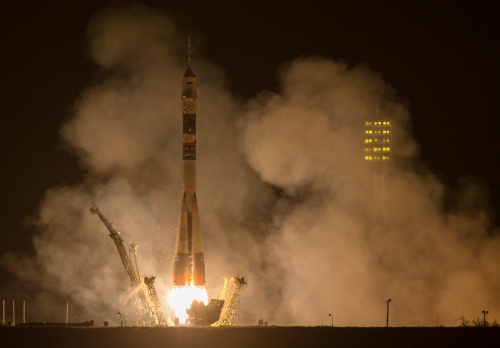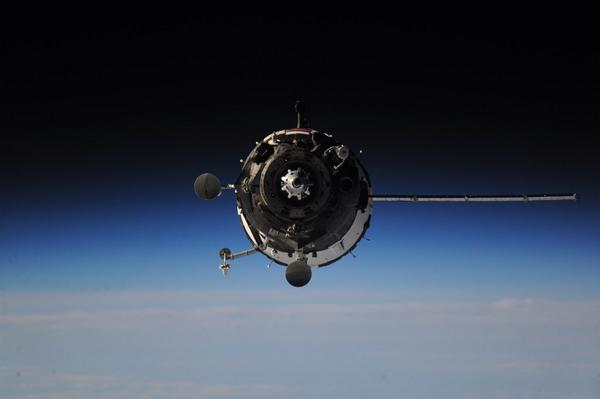
(Photo Credit: NASA/Joel Kowsky)
NASA astronaut Butch Wilmore and Russian cosmonauts Alexander Samokutyaev and Elena Serova have successfully joined their Expedition 41 crewmates after flawlessly launching, rendezvousing and docking to the International Space Station.
The hatches between the Soyuz TMA-14M spacecraft and the International Space Station were officially opened at 5:06 a.m. GMT (1:06 a.m EDT) and Expedition 41 Commander Max Suraev of the Russian Federal Space Agency and Flight Engineers Reid Wiseman of NASA and Alexander Gerst of the European Space Agency, who arrived at the station in May, welcomed their new crew members aboard their orbital home.
 (The crew waving goodbye before boarding their spacecraft – Photo Credit: NASA/Joel Kowsky)
(The crew waving goodbye before boarding their spacecraft – Photo Credit: NASA/Joel Kowsky)
The crew’s Soyuz TMA-14M spacecraft safely ferried them to the space station’s Poisk docking compartment after launching six hours earlier from the Baikonur Cosmodrome, despite a port solar array failing to deploy when the Soyuz reached orbit following liftoff.
The vehicle managed to rendezvous and dock to the station without both arrays however, luckily, the array did deploy later. Experts are still unsure why the fault occurred, but NASA and Roscosmos officials have confirmed that the array poses no long term issue to either standard operations at the station for Expedition 41-42, or for the crew at the conclusion of their mission in March.
Shortly after hatch opening, Butch, Alexander and Elena floated into their new home for a welcoming ceremony and congratulatory calls from family, friends and mission officials in Baikonur. After the ceremony ended, the new crew underwent a mandatory safety orientation to familiarize themselves with escape paths and procedures and locations of safety gear before heading to bed.
Following their late night, the six-member crew will have an off-duty day on Friday to relax. They will resume unloading cargo from the SpaceX Dragon, which arrived Tuesday morning, on Saturday. The new trio will then spend the next several days adjusting to life on the space station and familiarizing themselves with procedures and the numerous systems onboard the orbital laboratory.
Serova is on her first mission, however she has already made history: she is Russia’s first female cosmonaut to live and work on the International Space Station.
This is Wilmore’s second visit to the space station. He piloted space shuttle Atlantis in November 2009 which delivered two EXPRESS Logistics Carriers carrying station gear and returned Expedition 20/21 crew members back to Earth.
Samokutyaev is also beginning his second stint at the orbital laboratory having served as an Expedition 23/24 Flight Engineer alongside Alexander Skvortsov, who left the station two weeks ago.
 (Photo Credit: NASA/Aubrey Gemignani)
(Photo Credit: NASA/Aubrey Gemignani)
They join Commander Max Suraev and Flight Engineers Reid Wiseman and Alexander Gerst. The international trio, from Roscosmos, NASA and the European Space Agency, have been aboard the orbital complex since May 28.
The new six-man crew will be working off the Earth, for the Earth, conducting hundreds of scientific investigations and technology demonstrations during their mission on the orbiting laboratory. This research includes seedling growth, observation of meteors entering Earth’s atmosphere and studies of animal biology and bone and muscle physiology.
Some of the cargo flown aboard the crew’s Soyuz spacecraft will also be used in research investigations. Items such as questionnaires will be delivered to obtain in-flight data about crew member characteristics, such as day-to-day changes in health or incidence of pain or pressure.
 (The Soyuz approaching the station for docking with only one array deployed – Photo Credit: Reid Wiseman/NASA)
(The Soyuz approaching the station for docking with only one array deployed – Photo Credit: Reid Wiseman/NASA)
Among the more interesting experiments packed inside the Soyuz are a number of Zebrafish that will live in the Japanese Kibo laboratory’s Aquatic Habitat. Investigators will observe the fish to study the chemical signals, proteins and cellular activity that lead to muscular atrophy caused by long-term exposure to microgravity.
Researchers will also use biological sample kits delivered by the spacecraft to obtain samples of blood, saliva or urine. The ongoing collection of biological samples from crew members help scientists determine if immune system impairment caused by spaceflight increases the possibility for infection or poses a significant health risk during life aboard the space station.
 (The new six-member Expedition 41 crew gathers in the Zvezda service module for a welcoming ceremony with family and friends – Photo Credit: NASA TV)
(The new six-member Expedition 41 crew gathers in the Zvezda service module for a welcoming ceremony with family and friends – Photo Credit: NASA TV)
The new crew members will perform educational activities, television interviews, and one Russian and as many as three U.S. spacewalks. They will also greet two Russian Progress spacecraft resupply flights, the third commercial resupply flight of Orbital Science’s Cygnus spacecraft and the fifth and sixth flights of SpaceX’s Dragon cargo spacecraft.
Suraev, Wiseman and Gerst will return home on November 9. At that time, Wilmore will become commander of the station for Expedition 42 until Wilmore, Samokutyaev and Serova return to Earth on March 11, 2015.
You can view a full album of Expedition 41/42’s launch here. Additionally, if you missed liftoff, docking and hatch opening, you can watch them below:
[Video Credit: ReelNASA]
